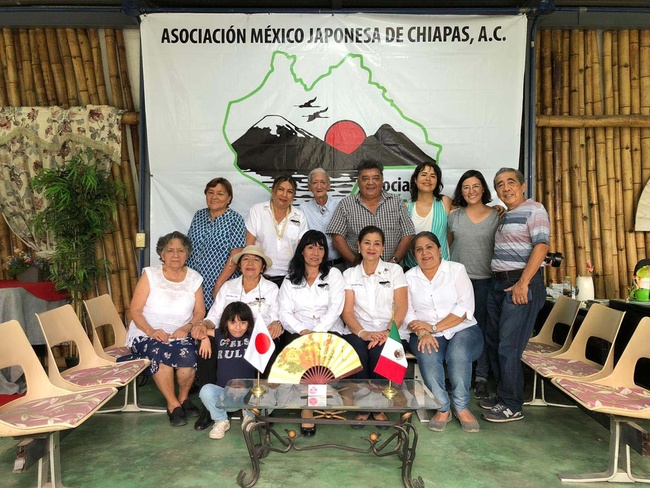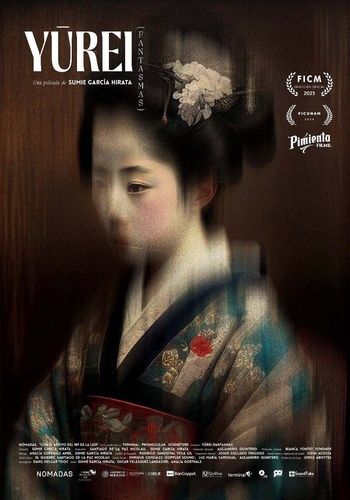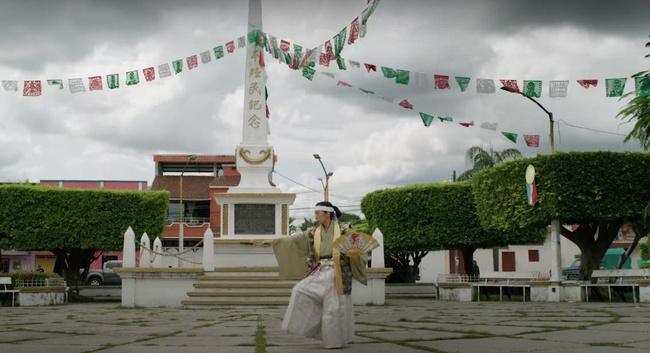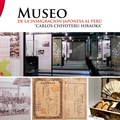Yurei ( Ghosts ) is memory, silences, nostalgia and secrets. The documentary directed by Mexican filmmaker Sumie García Hirata delves into the history of Japanese immigration to Mexico, marked by untransmitted experiences, hidden by its protagonists from their descendants.
A history marked, as in the United States or Peru, by the Second World War.
“The term Yurei represents those ghosts of the past, the stories that have not been told, the silenced memories that have endured through generations and that haunt the present,” says Sumie.
“Many of these painful moments were not spoken about openly, as a kind of collective secret, something that was buried but that continues to affect people's identity,” she adds.
Not all silences, however, are negative. There are also “pleasant memories of the participants’ ancestors (whose testimonies are collected in the work) that are expressed through cultural and family traditions. In the documentary, we try to break those silences, to give voice to the broad experiences of the Nikkei in Mexico.”
A review of history
If we talk about history, an authoritative voice is that of the Mexican anthropologist Dahil Melgar Tísoc, author of several works on Japanese immigration to her country and who was in charge of the research that made the materialization of Yurei possible.
Dahil reveals that during the war, 13 Latin American countries implemented “atrocious policies against Japanese and their descendants.”
In one of them, Mexico, there were “proscriptions of property rights, possession and management of capital, mobility restrictions, surveillance policies, the prohibition of residing within 100 km of any Pacific coast and 200 km of the border between Mexico and the United States, and, finally, orders for immediate concentration in authorized cities (most of them in the center of the country).”
As a result of the repressive measures, many Japanese families lost their homes and businesses, literally being left out in the cold.
While some managed to weather the storm thanks to their ties to local power circles, most had to pool their meager resources and share a roof with other Japanese in overcrowded spaces or move to farms “provided by the Japanese Colony Mutual Aid Committee.”
The first of these was El Batán, located in Mexico City and owned by the Japanese architect Tatsugoro Matsumoto. Later, Castro Urdiales, in Jalisco, and Temixco, in Morelos, were bought specifically to house displaced people.
Dahil explains that the occupants of the aforementioned farms were allowed to leave them during the day, which differentiated them from concentration camps in the United States. However, “for many families it was the only option they had to protect themselves from the anti-Japanese climate of the time, but above all to ensure a roof over their heads and their food self-sufficiency through collective agricultural work.”
Innocent victims of a war that was taking place on the other side of the ocean and with which they had nothing to do, stigmatized only for having been born in the “enemy” country, the immigrants buried the memories of exile and abuse, turned the page and decided to move forward without looking back.
As a result of their silence, later generations grew up unaware of their community's past.
However, there were experiences that were transmitted and that shaped or left traces on their descendants. In Yurei , the Nikkei say that “experiences are inherited” or “I am shocked to be the granddaughter of a picture bride (a woman who married an Issei whom she only knew from a photograph and who then traveled to the country to which he had migrated).”
Women played a fundamental role in preservation.
“During the interviews we found that in many cases the transmission of family history by word of mouth was through women. I think that in many cases, and not only in Nikkei families, the sense of community and family is woven by women,” says the director of the documentary.
One of the Nikkei interviewees states that “memory and nostalgia play an important role in identity, a nostalgia that is inherited and constructed.”
Sumie explains: “Nostalgia permeates the memories of descendants, like a kind of emotional inheritance. Although most of the people we interviewed did not directly experience migration or the war period, they carry with them the weight of those memories transmitted by their grandparents, parents or mothers.”
“It is a nostalgia that does not necessarily come from what has been experienced, but from feelings, vague memories and intuitions. This nostalgia helps to build an identity, because it is often what connects current generations with their past. It is a shared memory, a kind of emotional legacy that shapes how we see ourselves and how we relate to our history,” he adds.
However, memory is not an electronic device that faithfully records events. The past we narrate is the one we remember, not necessarily the one that was. The stories we tell ourselves are elastic, variable, stories that undergo small or large alterations as time goes by.
“Through my work in film and visual arts, I have explored memory and the different elements that make it up. One aspect is the way we remember specific memories: when you remember something, you remember the last time you thought about that memory and we don’t remember the moment itself. So, over time, everything becomes the memory of the memory of the memory of the moment that we seek to maintain. In this repetition, it is natural for changes to occur. Because of this, we never remember the events as they happened, they are filtered through the prism of our emotions, our experiences, and what we have heard from others,” he says.
In the documentary, “I try to show this creative reconstruction of memory. For many Nikkei, the past of their ancestors is full of gaps and silences, but these gaps are filled with stories that have been inherited in an emotional and imaginative way, which allows a connection to that past to remain alive, even if it is not entirely accurate or linear.”
Memory is a foundation of identity, a topic that Yurei addresses through her participants, one of whom speaks of the “theatricality of identity,” which pushes people to conform to the labels that society places on them based on their surnames, physiognomy or ethnic origin. Something like saying that if you have Japanese ancestors you have to be a karateka.
Yurei is a champion of flexibility and individual autonomy, of expressing yourself as you are born or desire, without your ethnicity being a straitjacket.
“The documentary is a reflection and an empathetic invitation for all of us to think about the expectations we feel when representing a specific identity. By pointing towards the theatricality of identity, although the documentary speaks about certain elements of Nikkeiness, I would like to think that any audience can identify with the idea of dressing up as the identities we assume,” says Sumie.
“Identity is not something fixed, but something that we constantly construct and adapt, and I hope that when reflecting on what we seek to represent, there is the freedom to do so of our own free will and not because of stereotypes or social impositions,” she concludes.
What cannot be said in words
Yurei is not a conventional documentary, a classic narrative in which testimonies follow one another in a linear fashion. Stories without narrators or seasoned with new ingredients in each evocation, gaps filled by imagination, blurred memories, invited other expressive forms that were found, for example, in Japanese art.
Dahil explains that “the narrative, in addition to being a thread of the geographies of memory, had to add the role of silences and the geographies of oblivion. These had been present in the narratives of the past, whose details became blurred with the passage of time, but also in the poetics of the material, such as in the patina of dust or the traces of humidity that had erased the features of an object, the faces of the people present in family photographs, or the names written in kanji on tombstones.”
“The very process of being in these multiple geographies and listening to the experiences of various people in the community required us to question as a team whether we should articulate these memories in an open narrative, made up of multiple interviews, or respect the language of memory itself in its abstraction, the weight of silence and oblivion and its subtle winks and gestures,” she adds.
Thus, they chose to “present the story between what can be said with words and what is unspeakable, for which we use other languages such as dance ( noh , butoh , rural and festive), the landscape, the geographies of memory, the artifacts and the places in which this story is symbolized.”
The project was born from conversations that Sumie and Dahil began having in 2019 about the history of Japanese immigration to Mexico and community development.
Between 2019 and 2020, both of them, together with members of the team that produced the documentary, made exploratory trips around the North American country.
“For me, it was important to begin the visual and narrative journey on the southern border, in Soconusco (in Chiapas), where the history of Japanese migration to Mexico began in 1897. And, from there, to delve into the border counterpart of this origin, in the north of the country, in Ensenada-Tijuana, where Japanese had settled between the 1920s and 1930s, attracted by the fishing boom, the commercial-tourist development promoted by the American prohibition law and the always complex relationship between Mexico and the United States,” recalls Dahil.
On their travels, thanks to organizations such as the Mexican Japanese Association of Chiapas and the Japanese Association in Ensenada, and people such as Kiyoko Nishikawa (Ensenada), Yoshio Cruz Nakamura (Tapachula), Miguel Nakamura (Escuintla) and Martin Nomura (Acacoyagua), they collected testimonies, had access to old family photos and objects, and visited cemeteries that house the remains of the pioneers as well as the homes and businesses of the first Japanese immigrants.

To close the discussion on history, Dahil tells us about the first official Japanese migration project to Latin America, in 1897, which had Mexico as its destination: the Enomoto colony.
“Named after its promoter, Viscount Takeaki Enomoto, it consisted of the migration of 36 Japanese men who settled between the current municipalities of Escuintla and Acacoyagua, attracted by the promise of their own land and the riches promised by an era marked by coffee fever and the success of other foreign agricultural colonization projects promoted by the Porfiriato (period during which Mexico was governed by Porfirio Díaz),” he explains.
The initiative failed “due to malaria, yellow fever, inexperience in the use of coffee crops (a grain that was largely unknown to the Japanese) and hunger. When the Enomoto colony closed, only 16 Japanese migrants remained in the region, who formed families with Mexican women and diversified their economy through other crops, livestock and services,” he adds.
Despite the setback, Japanese migration to Mexico did not stop and in 1903 a second group of Issei arrived, a new milestone in a powerful history of more than 125 years that the documentary Yurei illuminates with rigor, art and sensitivity.
Trailer: Yurei
© 2025 Enrique Higa Sakuda












